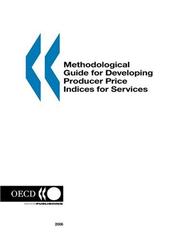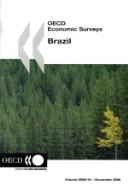| Listing 1 - 10 of 16 | << page >> |
Sort by
|

ISBN: 1462331084 1451994621 1589063309 Year: 2006 Publisher: Washington, D.C, : International Monetary Fund,
Abstract | Keywords | Export | Availability | Bookmark
 Loading...
Loading...Choose an application
- Reference Manager
- EndNote
- RefWorks (Direct export to RefWorks)
The consumer price index (CPI) measures the rates at which the prices of consumer goods and services are changing over time. It is a key statistic for purposes of economic and social policymaking, especially monetary policy and social policy, and has substantial and wide-ranging implications for governments, businesses, and workers, as well as households. This important and comprehensive manual provides guidelines for statistical offices and other agencies responsible for constructing CPIs and explains in depth the methods that are used to calculate a CPI. It also examines the underlying economic and statistical concepts and priniciples needed for making choices in efficient and cost-effective ways and for appreciating the full implications of those choices. The following international organizations, concerned both with the measurement of inflation and with policies designed to control it, have collaborated on the preparation of this manual: the International Labour Office; the International Monetary Fund; the Organization for Econmomic Co-operation and Development; the Statistical Office of the European Communities (Eurostat); the United Nations Economic Commission for Europe; and the World Bank.
Consumer price indexes --- Price indexes --- Price indices --- Index numbers (Economics) --- Methodology.
Book
ISBN: 926402817X Year: 2006 Publisher: Paris : OCDE-Organisation de cooperation et developpement economiques,
Abstract | Keywords | Export | Availability | Bookmark
 Loading...
Loading...Choose an application
- Reference Manager
- EndNote
- RefWorks (Direct export to RefWorks)
Les indices de prix peuvent être construits selon une méthode dite « hédonique ». Cette méthode prend en compte les changements intervenus dans la qualité du produit en s’appuyant sur un ensemble de caractéristiques clés du produit. L’objectif de ce manuel est d’aider le lecteur à mieux comprendre les avantages et les inconvénients des méthodes classiques et hédoniques, et de lui offrir un fondement analytique sur lequel appuyer son choix. Cet ouvrage dégage des « bonnes pratiques » à suivre pour construire des indices hédoniques et examine les critiques adressées à ces indices. Le manuel regroupe non seulement des éléments dispersés jusqu’alors dans un grand nombre de publications, mais dépasse la littérature économique existante à plusieurs égards. Il a été rédigé principalement à l’intention des organismes statistiques, qui ne disposaient pas jusque-là de manuel regroupant les principes à suivre pour mener des études hédoniques.
Electronic books. -- local. --- Price indexes. --- Quality of products. --- Business & Economics --- Economic Theory --- Product quality --- Price indices --- Consumer protection --- Quality control --- Workmanship --- Index numbers (Economics)

ISBN: 128174705X 9786611747053 9264028153 9264028145 Year: 2006 Publisher: Paris : OECD,
Abstract | Keywords | Export | Availability | Bookmark
 Loading...
Loading...Choose an application
- Reference Manager
- EndNote
- RefWorks (Direct export to RefWorks)
Price indexes can be constructed using a “hedonic method” that adjusts for changes in the quality of a product by focusing on a set of key product characteristics. This handbook contributes to a better understanding of the merits and shortcomings of conventional and hedonic price indexes and methods, and provides an analytic basis for choosing among them. It sets out “best practice” principles for constructing hedonic indexes and examines criticisms of hedonic indexes. The handbook brings together material that is now scattered in a wide number of places, but goes beyond the economic literature in significant respects. It has been written because there is a widespread view that the principles for conducting hedonic investigations are not readily assembled for statistical agency work, which is the primary audience of this volume.
Science and Technology --- Economics --- Price indexes --- Quality of products --- Business & Economics --- Economic Theory --- Price indexes. --- Quality of products. --- Product quality --- Price indices --- Consumer protection --- Quality control --- Workmanship --- Index numbers (Economics)
Book
ISBN: 9264025200 9264025197 Year: 2006 Publisher: Paris : OECD,
Abstract | Keywords | Export | Availability | Bookmark
 Loading...
Loading...Choose an application
- Reference Manager
- EndNote
- RefWorks (Direct export to RefWorks)
Economic indicators -- Germany. --- Electronic books. -- local. --- Germany (West) -- Economic conditions. --- Germany (West) -- Economic policy. --- Business & Economics --- Economic History --- Economic indicators --- Germany (West) --- Economic conditions. --- Economic policy. --- Business indicators --- Indicators, Business --- Indicators, Economic --- Leading indicators --- Economic history --- Quality of life --- Economic forecasting --- Index numbers (Economics) --- Social indicators
Book
ISBN: 0821367048 9786610564620 1280564628 0821367056 Year: 2006 Publisher: Washington, DC : World Bank,
Abstract | Keywords | Export | Availability | Bookmark
 Loading...
Loading...Choose an application
- Reference Manager
- EndNote
- RefWorks (Direct export to RefWorks)
A pocket-sized reference on key development data for over 50 countries in Africa, this book provides profiles of each country with 54 development indicators about people, environment, economy, technology, infrastructure, trade and finance. A must have for anyone interested in today's development challenges in sub-Saharan Africa.
Africa -- Economic conditions -- 21st century. --- Africa -- Social conditions -- 21st century. --- Economic indicators. --- Economic indicators --- Social indicators --- Africa --- Economic conditions --- Social conditions --- Indicators, Social --- Business indicators --- Indicators, Business --- Indicators, Economic --- Leading indicators --- Quality of life --- Social history --- Social accounting --- Social prediction --- Economic history --- Economic forecasting --- Index numbers (Economics) --- Eastern Hemisphere
Book
ISBN: 1451864418 1462360904 1451988206 9786613823304 1452725926 1283071088 Year: 2006 Publisher: Washington, D.C. : International Monetary Fund,
Abstract | Keywords | Export | Availability | Bookmark
 Loading...
Loading...Choose an application
- Reference Manager
- EndNote
- RefWorks (Direct export to RefWorks)
Statistical offices try to match item models when measuring inflation between two periods. For product areas with a high turnover of differentiated models, however, the use of hedonic indexes is more appropriate since they include the prices and quantities of unmatched new and old models. The two main approaches to hedonic indexes are hedonic imputation (HI) indexes and dummy time hedonic (DTH) indexes. This study provides a formal analysis of the difference between the two approaches for alternative implementations of the Törnqvist "superlative" index. It shows why the results may differ and discusses the issue of choice between these approaches.
Electronic books. -- local. --- Inflation (Finance). --- Price indexes. --- Finance --- Business & Economics --- Money --- Inflation (Finance) --- Price indices --- Index numbers (Economics) --- Natural rate of unemployment --- Investments: Metals --- Finance: General --- Macroeconomics --- Price Level --- Inflation --- Deflation --- Metals and Metal Products --- Cement --- Glass --- Ceramics --- General Financial Markets: General (includes Measurement and Data) --- Investment & securities --- Consumer price indexes --- Silver --- Price indexes --- Commodity markets --- Commodity exchanges --- United States
Book
ISBN: 1451864698 1462357873 1451909225 9786613820457 1452738033 1282392026 Year: 2006 Publisher: Washington, D.C. : International Monetary Fund,
Abstract | Keywords | Export | Availability | Bookmark
 Loading...
Loading...Choose an application
- Reference Manager
- EndNote
- RefWorks (Direct export to RefWorks)
This paper reviews alternative approaches to measuring an economy's cost competitiveness and proposes some new measures inspired by the economic theory of index numbers. The indices provide a theoretical benchmark for estimated real effective exchange rates, but differ from standard measures in that they are based on marginal rather than average sectoral shares in GDP or employment. The use of the new indices is illustrated by some simple calculations that highlight the potential exposure of the Irish economy to fluctuations in the euro-sterling exchange rate.
Competition -- Econometric models. --- Electronic books. -- local. --- Index numbers (Economics). --- Ireland -- Economic conditions. --- Business & Economics --- Economic Theory --- Competition --- Index numbers (Economics) --- Econometric models. --- Ireland --- Economic conditions. --- Numbers, Index --- Competition (Economics) --- Competitiveness (Economics) --- Economic competition --- Economic aspects --- Economics --- Prices --- Economic indicators --- Indexation (Economics) --- Commerce --- Conglomerate corporations --- Covenants not to compete --- Industrial concentration --- Monopolies --- Open price system --- Supply and demand --- Trusts, Industrial --- Finance: General --- Foreign Exchange --- Labor --- Macroeconomics --- General Financial Markets: General (includes Measurement and Data) --- Price Level --- Inflation --- Deflation --- Employment --- Unemployment --- Wages --- Intergenerational Income Distribution --- Aggregate Human Capital --- Aggregate Labor Productivity --- Methodology for Collecting, Estimating, and Organizing Macroeconomic Data --- Data Access --- Finance --- Currency --- Foreign exchange --- Labour --- income economics --- Real effective exchange rates --- Consumer price indexes --- Cost of living --- Price indexes --- Economic theory --- Cost and standard of living --- Income economics

ISBN: 9789264030039 9264030034 9264030042 Year: 2006 Publisher: Paris : OECD,
Abstract | Keywords | Export | Availability | Bookmark
 Loading...
Loading...Choose an application
- Reference Manager
- EndNote
- RefWorks (Direct export to RefWorks)
The International Producer Price Index Manual (PPI Manual) published by the IMF in 2004, constituted a landmark for international standards on price measurement and contains detailed, comprehensive information for the compilation of producer price indices. This Methodological Guide for Developing Producer Price Indices for Services is a complement to the PPI Manual in two ways: it focuses on service-specific aspects in the PPI compilation by developing further the conceptual framework and it adds detailed descriptions of PPI measurement for a series of service industries. This Guide has been jointly produced by the OECD, Eurostat and the members of a Taskforce with delegates from 19 OECD/EU Member countries.
Price indexes. --- Prices. --- Indice des prix --- Prix --- AA / International- internationaal --- 301 --- 306.10 --- 307.64 --- Techniek van statistische inlichtingen. Organisatie van de statistische enquêtes. Statistische kritiek. --- Indexcijfers. --- Statistieken van de prijzen. --- Price indexes --- Prices --- Commercial products --- Commodity prices --- Justum pretium --- Price theory --- Consumption (Economics) --- Cost --- Costs, Industrial --- Money --- Cost and standard of living --- Supply and demand --- Value --- Wages --- Willingness to pay --- Price indices --- Index numbers (Economics) --- Techniek van statistische inlichtingen. Organisatie van de statistische enquêtes. Statistische kritiek --- Indexcijfers --- Statistieken van de prijzen

ISBN: 1281746940 9786611746940 926403000X 9264029990 Year: 2006 Publisher: Paris : OECD,
Abstract | Keywords | Export | Availability | Bookmark
 Loading...
Loading...Choose an application
- Reference Manager
- EndNote
- RefWorks (Direct export to RefWorks)
SPECIAL FEATURES.:.; Innovation.; Labour markets
Brazil -- Economic conditions -- Periodicals. --- Brazil -- Economic policy -- Periodicals. --- Brazil -- Economic policy. --- Economic indicators -- Brazil -- Periodicals. --- Quality of life -- Brazil -- Periodicals. --- Business & Economics --- Economic History --- Economic indicators --- Quality of life --- Brazil --- Economic conditions --- Economic policy. --- Life, Quality of --- Economic history --- Human ecology --- Life --- Social history --- Basic needs --- Human comfort --- Social accounting --- Work-life balance --- Business indicators --- Indicators, Business --- Indicators, Economic --- Leading indicators --- Economic forecasting --- Index numbers (Economics) --- Social indicators
Book
ISBN: 1281031836 9786611031831 1847651801 1847650201 9781847650207 1861979479 9781861979476 1861979749 Year: 2006 Publisher: Londen Profile books
Abstract | Keywords | Export | Availability | Bookmark
 Loading...
Loading...Choose an application
- Reference Manager
- EndNote
- RefWorks (Direct export to RefWorks)
Provides the keys to understanding the major economic indicators: what they are, the areas they cover, their reliability, and how and why to interpret them. This book contains chapters covering: GDP (Gross Domestic Product), GNP (Gross National Product) and GNI (Gross National Income); growth, trends and cycles; and more.
Economic indicators. --- Economic indicators --- Business indicators --- Indicators, Business --- Indicators, Economic --- Leading indicators --- Economic history --- Quality of life --- Economic forecasting --- Index numbers (Economics) --- Social indicators --- 338.12 --- 330.35 --- Business cycles --- 330.0112 --- Economic cycles --- Economic fluctuations --- Cycles --- 338.12 Conjunctuurbewegingen. Economische fluctuatie. Investeringscycli. Conjunctuuranalyse. Conjunctuuronderzoek. Conjunctuurprognoses --- Conjunctuurbewegingen. Economische fluctuatie. Investeringscycli. Conjunctuuranalyse. Conjunctuuronderzoek. Conjunctuurprognoses --- 330.35 Economische groei. Kwantitatieve toename. Technische vooruitgang --zie ook {338.09} --- Economische groei. Kwantitatieve toename. Technische vooruitgang --zie ook {338.09} --- Forecasting
| Listing 1 - 10 of 16 | << page >> |
Sort by
|

 Search
Search Feedback
Feedback About UniCat
About UniCat  Help
Help News
News